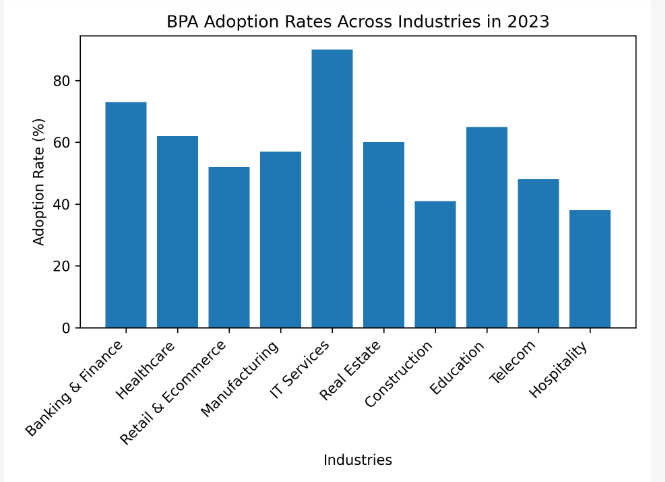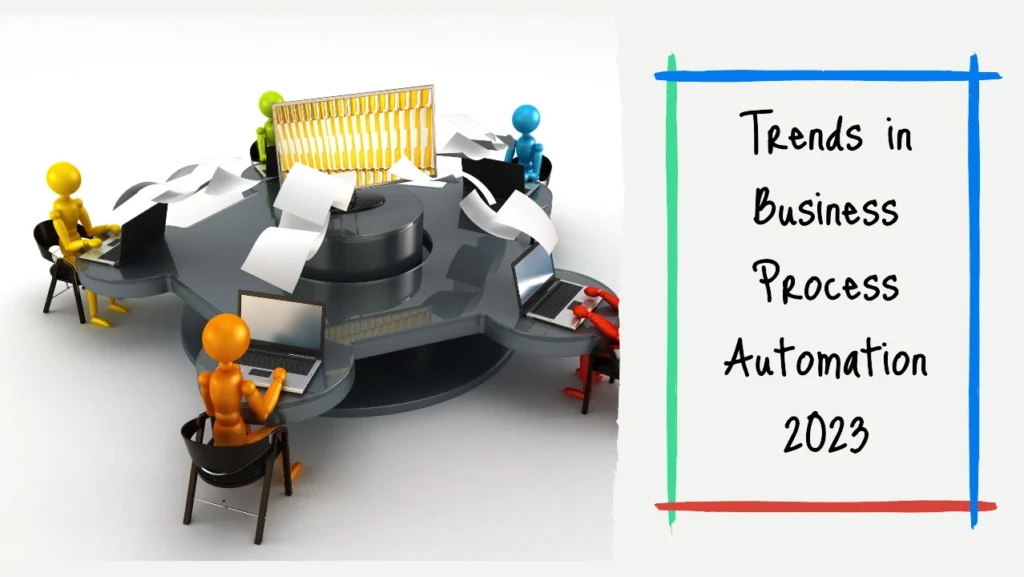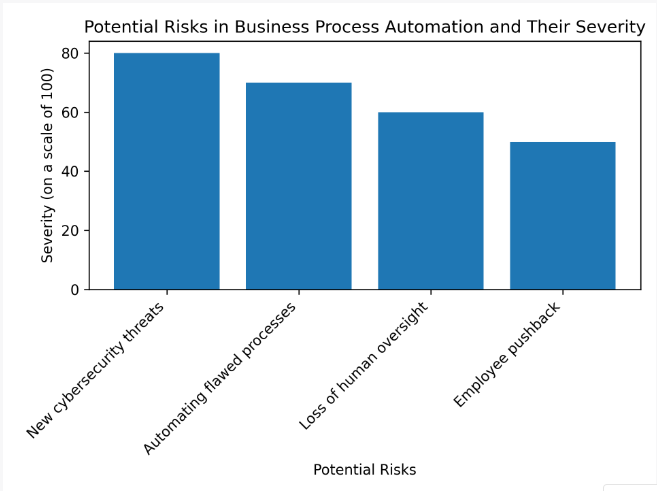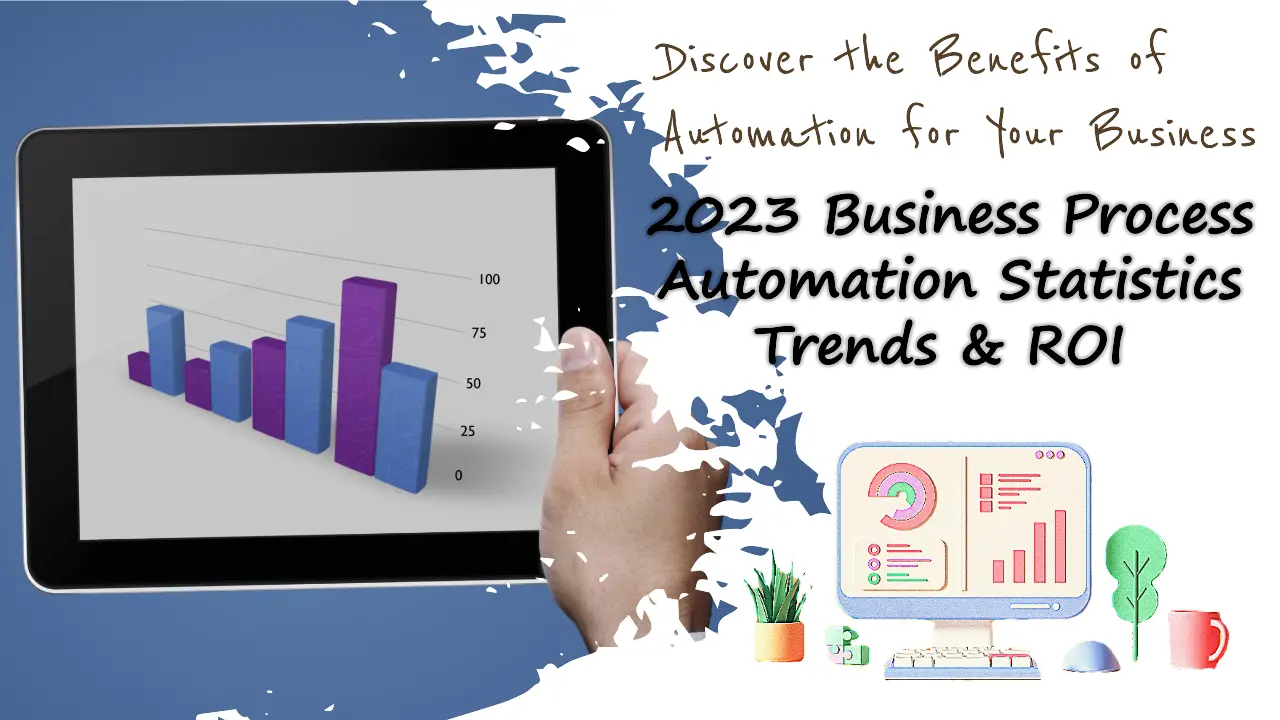Business process automation statistics – As digital transformation accelerates, business process automation (BPA) has emerged as a crucial efficiency tool. BPA leverages software and technologies like artificial intelligence to streamline workflows and business operations. Given the rapid growth of process automation, examining recent statistics and trends provides valuable insights for leaders evaluating implementation.
These business automation statistics reveal key data on adoption rates, return on investment, top use cases, projected growth, and real-world benefits and challenges. This overview will analyze the most current BPA data and trends for 2023 while exploring predictive analytics around the future. For executives and technologists weighing process automation, these statistics confirm ROI, surfacing key factors to consider. Let’s dive into the numbers to unlock automation’s immense potential.
What is Business Process Automation (BPA)?
The term “business process automation” (BPA) describes how repetitive labor, business processes, and workflows are automated using technology. Enhancing operational effectiveness is the aim. AI or software robots are used by BPA and are readily integrated into processes. Key processes automated include customer onboarding, reporting, reconciliation, claims processing, and more.

Historically, BPA evolved from workflow automation and business process management tools in the 1990s and 2000s. But capabilities soared with modern AI, machine learning (ML), and intelligent software robots. BPA adoption began accelerating in the 2010s across sectors from banking to healthcare as automation delivered tangible ROI.
Today over 80% of companies leverage some form of business process automation statistics. BPA is now a crucial technique for the digital transition that supports excellent workflow.
Benefits of Business Process Automation
Time and Cost Efficiency:
BPA drastically reduces operational costs associated with manual business processes. Automation eliminates waste through optimized workflows while limiting human labor requirements. Industry reports reveal organizations save 25-50% on costs after automation. Further savings come from fewer errors and rework. With automation delivering significant ROI, businesses obtain a competitive edge.
Boost Productivity and Efficiency:
Implementing business process automation (BPA) software and technologies can generate immense productivity gains. By digitizing manual workflows, BPA enables faster process completion, allowing employees to handle more transactions with fewer errors. Intelligent automation platforms integrate easily with existing systems, ensuring efficient handoffs between human and digital workers. According to 2022 statistics, over 62% of companies reported productivity gains after automation adoption.
Precision and Reliability:
- Error Reduction: Business processes, when automated, drastically minimize the chances of human errors, ensuring accuracy in every task.
- Consistent Outcomes: BPA guarantees that every process outcome aligns with the set quality standards, ensuring reliability.
Gaining a Competitive Edge:
- Swift Business Adaptations: In the evolving business landscape of 2023, BPA-equipped businesses can swiftly adapt to market changes, securing a competitive advantage.
- Innovation Drive: Leveraging BPA allows businesses to channel more resources towards innovation, staying ahead in the digital era.
Enhance Customer Experiences
Streamlining processes directly correlates to happier customers. BPA enables faster service delivery, issues resolution, and responses to inquiries. Companies leveraging automation provide better experiences through rapid fulfillment. And with software bots handling repetitive tasks tirelessly, human employees can focus on value-added customer interactions.
Staying Ahead in the Digital Age:
- Digital Trend Adaptation: BPA tools empower businesses to align with the latest digital trends, ensuring they remain relevant.
- Future-Ready Operations: By adopting BPA strategies, businesses are better equipped to navigate the technological advancements of the future.
Incorporating BPA into business operations not only optimizes performance but also positions businesses to thrive in the competitive digital marketplace of 2023 and beyond.
Current Business Process Automation Statistics for 2023
Widespread Industry Adoption Rates:
- Per recent surveys, over 80% of companies now use some form of business process automation (BPA).
- Leading industries include banking, healthcare, retail, and manufacturing. These sectors automated extensive manual workflows.
- Banking, insurance, and healthcare have adoption rates over 50%, automating processes like underwriting and claims.
- Over 30% of manufacturing and retail companies have deployed automation, driven by supply chain and inventory use cases.
- While early adopters focused on back-office functions, industries are now automating customer-facing processes.
- Functional areas like customer service, HR, IT, finance, and supply chain leverage automation the most.
- Adoption continues rising as more processes get digitized and businesses realize ROI.
Here’s the Flow chart representing the BPA adoption rates across various industries in 2023:

This chart provides a visual representation of how different sectors have embraced business process automation statistics, with IT Services leading the way, followed by Banking & Finance, Education, and Healthcare, among others.
Compelling Returns on Investment:
- On average, companies achieve 20-30% cost reductions within the first year of automation.
- The accounts payable process alone sees 60-80% lower operating costs after automation.
- Errors and rework drop by nearly 40% with automated quality control checks.
- By eliminating inefficiencies, BPA delivers over 10% productivity gains within 6 months.
Here’s a bar graph representing the compelling returns on investment from Business Process Automation (BPA):

The graph showcases:
- An average of 25% cost reductions within the first year of automation.
- A significant 70% reduction in operating costs for the accounts payable process post-automation.
- A 40% reduction in errors and rework due to automated quality control checks.
- Over 10% productivity gains achieved by eliminating inefficiencies within 6 months.
Surging Market Growth:
- The global process automation market grew by over 15% in 2022 to $14 billion and projection to reach $50 billion by 2025, representing over 15% CAGR.
- By 2025 projections show adoption increasing by another 50% across sectors.
- North America currently leads adoption, but the Asia Pacific region is forecasted to grow fastest at around 20% annually.
- Intelligent automation, including AI and machine learning, will propel future expansions.
- New technologies like AI and blockchain will unlock more use cases, fueling growth.
Here’s a bar graph representing the surging market growth in Business Process Automation statistics (BPA):

This visualization provides a clear picture of the significant growth and potential of the BPA market in the coming years.
Trends in Business Process Automation 2023

AI and Automation: A Powerful Combination:
- AI and machine learning integration are transforming BPA capabilities. Today, data analysis, pattern recognition, and prediction capabilities in automation software robots enable workflow optimization.
- Natural language processing (NLP) allows bots to comprehend unstructured data like emails, chats, and documents when automating processes.
- Automated processes become more intelligent as a result, making BPA more flexible and valuable.
Empowering Low-Code/No-Code Solutions:
- Low-code /no-code platforms enable configurable BPA without extensive technical expertise. These tools expand access for small and mid-size companies.
- With graphical interfaces for building workflows, even non-programmers can “train” software robots. This democratization effect drives broader automation adoption.
- Vendors are enhancing low-code process automation tools with AI-assisted modeling and process mining features, blurring lines with traditional BPA.
Accelerating Digital Transformations:
- The pandemic necessitated rapid digital transformations, with companies automating processes to remain resilient. This shift expanded BPA adoption.
- Automating paper-based processes and manual workflows became vital for business continuity during disruptions.
- Success stories are now inspiring companies in traditionally slow-adopting sectors like construction to pursue automation initiatives.
Examining Global vs Regional Trends:
- North America currently leads in BPA adoption, but Asia Pacific is expected to have the fastest growth at around 20% CAGR through 2025.
- Europe also anticipates robust expansion as automation initiatives aim to boost competitiveness.
- Factors driving APAC growth include rising wages, large manufacturing sectors, and huge consumer markets like China and India.
- Latin America’s adoption lags but should accelerate given high inflation and the need for efficiency gains.
- Industry spending levels vary by region, with North America averaging $140k annually compared to $78k in Europe and APAC.
- Multinational companies often pilot BPA initiatives in one region before scaling across their global enterprise.
Advancing Workflow Automation Statistics:
- Traditional workflow automation is evolving from linear, rules-based approaches to dynamic systems leveraging AI and machine learning.
- Intelligent workflow automation can adapt to changes, take next-best-action decisions, and continuously improve over time based on data patterns.
- End-to-end workflow automation now integrates robotic process automation, BPM platforms, and data orchestration capabilities.
- As workflow automation embeds deeper into core systems, it enables straight-through processing without human intervention.
- Advanced workflow automation reduces costs, speeds up processes, and provides greater visibility into end-to-end operations.
Challenges and Risks in Business Process Automation
Common obstacles in BPA implementation:
- Integrating automation with multiple complex legacy systems poses challenges around interfaces, data formats, and end-to-end orchestration.
- Lack of internal skills and change management know-how hampers adoption. Many struggle to drive technological change.
- Unclear business case linkage between automation initiatives and financial benefits affects funding.
- Process fragmentation from years of workarounds hinders understanding workflows to automate.
Overcoming Technical Obstacles:
- Legacy systems often lack APIs and interfaces needed to integrate with automation tools. Updated architectures facilitate integration.
- Migrating processes piecemeal can cause fragmentation. IT teams should take a holistic approach and roadmap.
- Many platforms still have limitations around unstructured data or complex approvals. Choosing the right tools for each process is key.
Driving Employee Adoption:
- Some staff view automation as a threat rather than a digital helper. Change management and training ease transitions.
- Involving employees in implementation, especially process experts, ensures buy-in. They provide insight into enhancements.
- Unclear handoffs between humans and digital cause friction. Well-designed workflows keep workers in rhythm.
Ensuring Compliance and Security:
- New risks around data access, system privileges, and fraud may emerge. Proactive risk assessments identify vulnerabilities.
- Appropriate controls govern automated processes to maintain compliance. Monitoring and audits add oversight.
- Organizations balance automation benefits with human checks and approvals in sensitive areas. Testing builds confidence in technology first.
Potential risks and How to Mitigate them:
Here’s a visual representation of the potential risks in Business Process Automation and their severity:

The table below provides further details on these risks and how to mitigate them:
| Potential Risks | Severity (on a scale of 100) | Mitigation Strategies |
|---|---|---|
| New cybersecurity threats | 80 | Implement controls like system access management, encryption, and continuous monitoring. |
| Automating flawed processes | 70 | First, optimize workflows, then automate to avoid amplifying bad practices. |
| Loss of human oversight and governance | 60 | Maintain necessary checkpoints and ensure separation of duties to retain human oversight. |
| Employee pushback due to job impact | 50 | Communicate that automation is designed to augment talent, not replace it, and provide training opportunities. |
Industries Leading the Way in BPA Adoption in 2023
E-commerce: Embracing the Digital Revolution
- Automated Customer Journeys: With the rise of online shopping, e-commerce platforms are leveraging BPA to streamline the customer journey, from product selection to checkout.
- Inventory Management: Automation tools help in real-time tracking of inventory, ensuring products are restocked promptly and overstock situations are minimized.
- Data-Driven Insights: BPA aids in collecting and analyzing customer data, enabling businesses to offer personalized shopping experiences and targeted marketing campaigns.
Healthcare: The Telehealth Transformation
- Patient Scheduling: Automation ensures seamless appointment bookings, reducing wait times and enhancing patient satisfaction.
- Remote Patient Monitoring: With the growth of telehealth, BPA tools help in the real-time monitoring of patients, sending alerts for any anomalies.
- Data Management: Storing and retrieving patient records becomes efficient, ensuring doctors have all the necessary information at their fingertips.
Real Estate: Modernizing Property Management
- Virtual Tours: Automation tools allow potential buyers or renters to take virtual tours of properties, reducing the need for physical visits.
- Document Processing: From lease agreements to sale deeds, BPA speeds up the documentation process, ensuring all paperwork is completed promptly and accurately.
- Property Maintenance: Automation assists in scheduling regular maintenance tasks, ensuring properties remain in top condition.
In 2023, as industries continue to recognize the benefits of BPA, its adoption is set to soar. The sectors mentioned earlier are merely scratching the surface, as numerous other industries are on the brink of leveraging automation’s potential to elevate efficiency, elevate customer experiences, and fuel expansion.
Tools and Software Driving BPA in 2023
Leading BPA Solutions:
- Major platforms like Pega, Appian, and Nintex offer full capabilities like process modeling, automation design, and analytics.
- Specialized AI tools like ABBYY and Hyperscience enable intelligent document processing and data extraction.
- Ecosystems are expanding with RPA bots, workflow apps, and microservices architecture.
Key BPA Software Features:
- User-friendly, low-code design environments allow no-code workflow building for non-developers.
- Integration adaptors connect systems while API support maximizes interoperability.
- Control centers provide real-time process monitoring, analytics, and intelligence.
- Native mobile access and digital workforce management ease bot deployment.
The Role of RPA:
- RPA bots excel at replacing repetitive human tasks by mimicking user actions.
- BPA suites orchestrate end-to-end processes while RPA augments workflows through hyperautomation.
- Integrating RPA and BPA combines complementary strengths – repetitive task completion and cross-application workflows.
Case Studies:
Transforming Retail: The E-Commerce Giant’s Journey:
- The Challenge: An international e-commerce brand was grappling with the complexities of handling massive order volumes, especially during peak seasons.
- BPA Solution: The brand integrated an automated system for order processing, inventory checks, and customer communication.
- Impact: The result was a 45% boost in order processing efficiency, a significant reduction in manual errors, and an enhanced customer purchase experience.
- Key Insight: Automation can be a game-changer in sectors where timely response and efficiency are critical for customer satisfaction.
Revolutionizing Healthcare: A Hospital Chain’s Success Story:
- The Challenge: A prominent healthcare provider faced bottlenecks in patient scheduling, leading to longer wait times and patient dissatisfaction.
- BPA Solution: The hospital introduced an automated patient management system, streamlining appointment bookings, medical record updates, and billing.
- Impact: Patient wait times were slashed by 25%, administrative errors saw a 30% drop, and patient feedback scores soared.
- Key Insight: In industries like healthcare, where precision and timeliness are paramount, BPA can significantly elevate service quality.
Banking Reimagined: Seamless Customer Onboarding:
- The Challenge: A top-tier bank’s customer onboarding process was cumbersome, causing potential clients to abandon the process midway.
- BPA Solution: The bank employed robotic process automation (RPA) for instant document verification and real-time account activation.
- Impact: Customer onboarding became 50% quicker, leading to a 35% uptick in new account creations and enhanced client trust.
- Key Insight: In sectors where competition is fierce, like banking, swift and efficient customer experiences powered by BPA can set a brand apart.
Gleaning Lessons from BPA Triumphs:
- Adaptability is Crucial: BPA solutions should be tailored to address specific challenges. A generic approach might not yield the desired results.
- Employee Empowerment: While automation streamlines processes, the human touch remains invaluable. Regular training ensures that staff can work harmoniously with automated systems.
- Iterative Approach: BPA isn’t a one-time solution. Regular evaluations and updates ensure that the system remains aligned with evolving business needs.
BPA is using technology like AI and software robots to automate business workflows and procedures.
Automation benefits companies through cost savings, improved efficiency, reduced errors, faster processes, and elevated customer experiences.
Recent surveys indicate over 80% of companies leverage some form of process automation today.
Companies typically achieve 20-30% cost reductions and 40% faster process completion times with automation.
Common automated processes include billing, customer service, reporting, order processing, payroll, and inventory management.
Potential BPA risks include integration challenges, security vulnerabilities, lack of transparency, and employee pushback on adoption.
Business process automation adoption and market growth have been accelerating rapidly year over year across metrics like ROI, use cases, and spending.

Wrapping Up
These days, business process automation statistics is changing the game. Businesses that use it gain greatly, with simpler processes, cheaper expenses, and happy clients. Data clearly demonstrate that automation is not just a marketing hype.
When done well, it produces genuine competitive benefits. A new level of efficiency is revealed by reevaluating processes through the lens of automation. By combining cutting-edge technologies with creativity, innovation is generated. The competition is being overtaken by leaders in automation adoption.
But success doesn’t come easy. Experience shows change management is critical when rolling out new tech. And staying flexible to keep optimizing workflow improvements is key.
Forward-thinking companies treat automation as a mindset, not a one-off project. They embed it into how they operate and strategize. Utilizing the most recent statistics and trends in automation gives these nimble businesses that additional edge.
The formula is simple – combine automation’s possibilities with human creativity and ambition. Shake well and serve industry disruption. You will always be able to innovate faster than your competitors with this long-term strategy.
Muhammad Asif Saeed has extensive experience in commerce and finance. Specifically, He holds a Bachelor of Commerce degree specializing in Accounts and Finance and an MBA focusing on Marketing. These qualifications underpin his understanding of business dynamics and financial strategies.
With an impressive 20-year career in Pakistan’s textile sector, including roles at Masood Textile (MTM) and Sadaqat Limited, excelling in business & financial management. His expertise in financial and business management is further evidenced by his authoritative articles on complex finance and business operation topics for various renowned websites including businessproplanner.com,businesprotips.com,distinctionbetween.com, trueqube.com, and bruitly.com, demonstrating his comprehensive knowledge and professional expertise in the field.


6 thoughts on “Business Process Automation Statistics: Must-Know Trends & ROI”